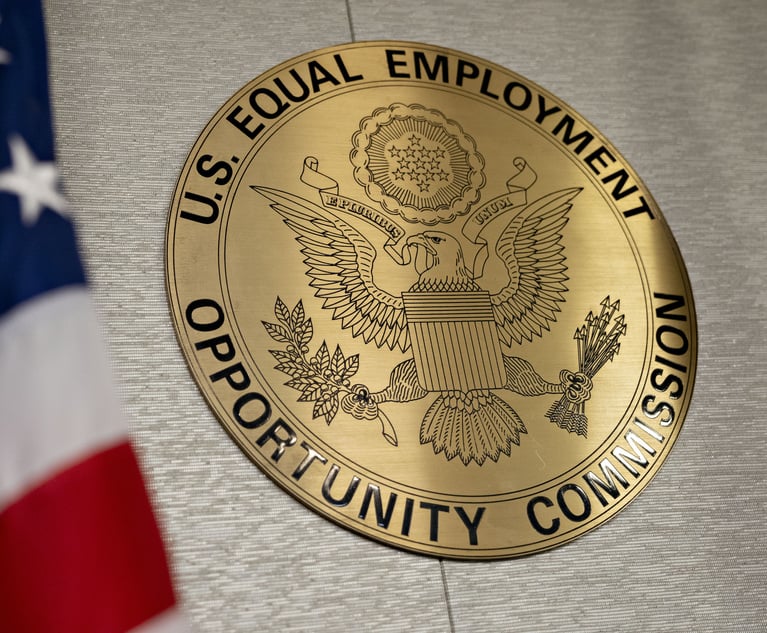E-discovery: Resolving issues through a collaborative approach
Every so often, a court case makes you look at a particular issue in a new way.
November 13, 2012 at 02:15 AM
7 minute read
The original version of this story was published on Law.com
Every so often, a court case makes you look at a particular issue in a new way. Northern District of Illinois Magistrate Judge Nan Nolan's recent decision in Kleen Products LLC v. Packaging Corporation of America is such a case. It demonstrates both the complexity of e-discovery and the ability for the court and the parties involved to work collaboratively from the outset of discovery and resolve issues in an expedited and efficient manner.
Kleen Products originated from a number of class action suits alleging antitrust violations in the containerboard industry brought against Georgia-Pacific LLC, Packaging Corp. of America, International Paper Co., Cascades Canada Inc., Weyerhaeuser Co., Temple-Inland Inc. and Smurfit-Stone Container Corp. The containerboard industry, which produces the principal raw material used to manufacture corrugated products, had been the subject of antitrust lawsuits for decades.
After surviving the defendants' motion practice, the plaintiffs served all of the defendants in Kleen Products seeking written discovery on 94 categories of documents in order to establish that the defendants fixed the price of containerboard during a specific period of time. As might be expected, the defendants disputed the scope of the discovery on several points, including:
- the relevant time period;
- the manner in which the defendants were required to search for electronically stored information (ESI), including search methodology;
- the number of employees required to search for responsive documents; and
- whether the scope included information archived on back-up tapes.
After the case was referred to Nolan, she conducted hearings and conferences in an attempt to work through the disputes. Over a period of approximately six months, she oversaw two days of evidentiary hearings, conducted 11 status hearings and Rule 16 conferences with all parties, and facilitated three additional Rule 16 conferences between the plaintiffs and specific defendants.
Through this effort and significant dedication of time, the parties and Nolan resolved many of the issues and narrowed the scope of those that remained unresolved. The court's and parties' collaborative approach unquestionably yielded significant benefits for all involved by significantly truncating the litigation process.
Nolan outlined certain lessons that she learned from all parties working together in the Kleen Products litigation. She stated that first, “the approach should be started early in the case. It is difficult or impossible to unwind procedures that have already been implemented.” Nolan clearly took a collaborative approach from the moment she was assigned the case. Second, according to her, “in multiple-party cases represented by separate counsel, it may be beneficial for liaisons to be assigned to each party.” Lastly, Nolan stated that “to the extent possible, discovery phases should be discussed and agreed to at the onset of discovery.”
Without question, the ESI issues involved in Kleen Products were complicated and difficult. One could imagine the parties fighting over these issues for years. However, because of the proactive and collaborative approach Nolan adopted from the onset of the discovery process, most of the issues were resolved within 10 months. The manner in which Nolan accomplished that outcome is something that counsel should take notice of going forward. Nolan herself recognized this when she stated that “[i]n some small way, it is hoped that this Opinion can be of some help to others interested in pursuing a cooperative approach.”
Every so often, a court case makes you look at a particular issue in a new way. Northern District of Illinois Magistrate Judge Nan Nolan's recent decision in Kleen Products LLC v.
Kleen Products originated from a number of class action suits alleging antitrust violations in the containerboard industry brought against
After surviving the defendants' motion practice, the plaintiffs served all of the defendants in Kleen Products seeking written discovery on 94 categories of documents in order to establish that the defendants fixed the price of containerboard during a specific period of time. As might be expected, the defendants disputed the scope of the discovery on several points, including:
- the relevant time period;
- the manner in which the defendants were required to search for electronically stored information (ESI), including search methodology;
- the number of employees required to search for responsive documents; and
- whether the scope included information archived on back-up tapes.
After the case was referred to Nolan, she conducted hearings and conferences in an attempt to work through the disputes. Over a period of approximately six months, she oversaw two days of evidentiary hearings, conducted 11 status hearings and Rule 16 conferences with all parties, and facilitated three additional Rule 16 conferences between the plaintiffs and specific defendants.
Through this effort and significant dedication of time, the parties and Nolan resolved many of the issues and narrowed the scope of those that remained unresolved. The court's and parties' collaborative approach unquestionably yielded significant benefits for all involved by significantly truncating the litigation process.
Nolan outlined certain lessons that she learned from all parties working together in the Kleen Products litigation. She stated that first, “the approach should be started early in the case. It is difficult or impossible to unwind procedures that have already been implemented.” Nolan clearly took a collaborative approach from the moment she was assigned the case. Second, according to her, “in multiple-party cases represented by separate counsel, it may be beneficial for liaisons to be assigned to each party.” Lastly, Nolan stated that “to the extent possible, discovery phases should be discussed and agreed to at the onset of discovery.”
Without question, the ESI issues involved in Kleen Products were complicated and difficult. One could imagine the parties fighting over these issues for years. However, because of the proactive and collaborative approach Nolan adopted from the onset of the discovery process, most of the issues were resolved within 10 months. The manner in which Nolan accomplished that outcome is something that counsel should take notice of going forward. Nolan herself recognized this when she stated that “[i]n some small way, it is hoped that this Opinion can be of some help to others interested in pursuing a cooperative approach.”
This content has been archived. It is available through our partners, LexisNexis® and Bloomberg Law.
To view this content, please continue to their sites.
Not a Lexis Subscriber?
Subscribe Now
Not a Bloomberg Law Subscriber?
Subscribe Now
NOT FOR REPRINT
© 2025 ALM Global, LLC, All Rights Reserved. Request academic re-use from www.copyright.com. All other uses, submit a request to [email protected]. For more information visit Asset & Logo Licensing.
You Might Like
View All

Trending Stories
- 1How Some Elite Law Firms Are Growing Equity Partner Ranks Faster Than Others
- 2Fried Frank Partner Leaves for Paul Hastings to Start Tech Transactions Practice
- 3Stradley Ronon Welcomes Insurance Team From Mintz
- 4Weil Adds Acting Director of SEC Enforcement, Continuing Government Hiring Streak
- 5Monday Newspaper
Who Got The Work
J. Brugh Lower of Gibbons has entered an appearance for industrial equipment supplier Devco Corporation in a pending trademark infringement lawsuit. The suit, accusing the defendant of selling knock-off Graco products, was filed Dec. 18 in New Jersey District Court by Rivkin Radler on behalf of Graco Inc. and Graco Minnesota. The case, assigned to U.S. District Judge Zahid N. Quraishi, is 3:24-cv-11294, Graco Inc. et al v. Devco Corporation.
Who Got The Work
Rebecca Maller-Stein and Kent A. Yalowitz of Arnold & Porter Kaye Scholer have entered their appearances for Hanaco Venture Capital and its executives, Lior Prosor and David Frankel, in a pending securities lawsuit. The action, filed on Dec. 24 in New York Southern District Court by Zell, Aron & Co. on behalf of Goldeneye Advisors, accuses the defendants of negligently and fraudulently managing the plaintiff's $1 million investment. The case, assigned to U.S. District Judge Vernon S. Broderick, is 1:24-cv-09918, Goldeneye Advisors, LLC v. Hanaco Venture Capital, Ltd. et al.
Who Got The Work
Attorneys from A&O Shearman has stepped in as defense counsel for Toronto-Dominion Bank and other defendants in a pending securities class action. The suit, filed Dec. 11 in New York Southern District Court by Bleichmar Fonti & Auld, accuses the defendants of concealing the bank's 'pervasive' deficiencies in regards to its compliance with the Bank Secrecy Act and the quality of its anti-money laundering controls. The case, assigned to U.S. District Judge Arun Subramanian, is 1:24-cv-09445, Gonzalez v. The Toronto-Dominion Bank et al.
Who Got The Work
Crown Castle International, a Pennsylvania company providing shared communications infrastructure, has turned to Luke D. Wolf of Gordon Rees Scully Mansukhani to fend off a pending breach-of-contract lawsuit. The court action, filed Nov. 25 in Michigan Eastern District Court by Hooper Hathaway PC on behalf of The Town Residences LLC, accuses Crown Castle of failing to transfer approximately $30,000 in utility payments from T-Mobile in breach of a roof-top lease and assignment agreement. The case, assigned to U.S. District Judge Susan K. Declercq, is 2:24-cv-13131, The Town Residences LLC v. T-Mobile US, Inc. et al.
Who Got The Work
Wilfred P. Coronato and Daniel M. Schwartz of McCarter & English have stepped in as defense counsel to Electrolux Home Products Inc. in a pending product liability lawsuit. The court action, filed Nov. 26 in New York Eastern District Court by Poulos Lopiccolo PC and Nagel Rice LLP on behalf of David Stern, alleges that the defendant's refrigerators’ drawers and shelving repeatedly break and fall apart within months after purchase. The case, assigned to U.S. District Judge Joan M. Azrack, is 2:24-cv-08204, Stern v. Electrolux Home Products, Inc.
Featured Firms
Law Offices of Gary Martin Hays & Associates, P.C.
(470) 294-1674
Law Offices of Mark E. Salomone
(857) 444-6468
Smith & Hassler
(713) 739-1250







